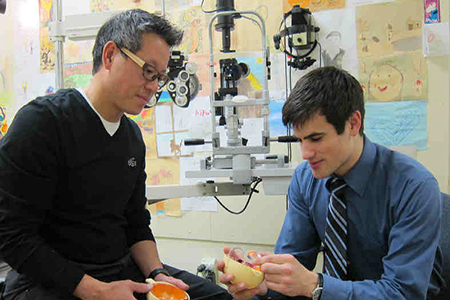You’re a progressive thinker, right? You’ve let go of the stereotypes about women not doing traditional “male” jobs and math geniuses breaking the fashion rules with pocket protectors. So why are you still clinging to the idea that engineering is all about building bridges and skyscrapers?
Today’s engineering majors might go on to find themselves in any of the following scenarios:
- A test engineer is spending his day crashing expensive sports cars into walls to make them safer.
- A forensic engineer is evaluating crime scene evidence to narrow down the search for a criminal.
- A design engineer is creating a robot that can save people from burning buildings.
- A pharmaceutical engineer is discovering a vaccine for a disease that has killed millions.
- A financial engineer is analyzing Wall Street’s patterns to try to predict future money-making trends.
So how do I prepare for engineering while I’m in high school?
Obviously, academic preparation is essential to exploring engineering as a career. In high school, classes in algebra, trigonometry, biology, physics, calculus, chemistry, computer programming or computer applications can tell you if you have the aptitude and determination to study engineering. While not all of these courses are required to get into every engineering school, early preparation can mean the difference between spending four or six years in college. Some universities also require two to three classes in a foreign language for admission. Advance placement or honors courses always help, as do high ACT and SAT scores.
But grades aren’t the only thing that matter. If you think you might be interested in engineering, get involved in engineering-related extracurricular activities to not only beef up your college application, but also to decide if you enjoy the field. Volunteer, intern or find a summer job working in a lab, a pharmacy, a police station or an architectural firm. Don’t be afraid to try a few different things until you find one you like. The possibilities are endless, and so are the job opportunities!
What are 3-2 programs?
Many engineering schools are teaming up with liberal arts colleges to offer 3-2 programs. Simply stated, a 3-2 program is an exchange program that allows you to take three years of liberal arts and two years of engineering to earn two degrees: a Bachelor of Arts and Bachelor of Science in engineering.
Usually, a liberal arts school will partner with an engineering school. The student will spend three years at their first school taking all of their foundation classes, and then transfer to the second school to complete the engineering portion of the program. The credit earned at the second school transfers back to the first school, allowing the student to graduate with two degrees. Not every school offers the 3-2 program, so be sure to do your research before deciding on a specific college.
Because of the increased need for engineers with excellent communication and “soft” skills (personal attributes that are measured more in your behavior and attitude than technical talent or education), the 3-2 program is a winning situation for both students and employers.
Another advantage of the 3-2 program is that it allows students to attend a smaller school with a better faculty-student ratio for their first three years of college.
What are the current trends in engineering?
With new advances in technology developing daily, every facet of engineering is evolving on a regular basis. Perhaps this is most prevalent in biomedical engineering, a subcategory in which industry professionals design instruments, software, and medical devices to help physicians, nurses, veterinarians, therapists and technicians solve complex medical problems and enhance the quality of medical care.
Biomedical engineers have plenty of choices when it comes to specializing, including, but not limited to:
- Bioinstrumentation: Using computers or electronics to measure, diagnose and treat disease.
- Biomaterials: Working with living tissue and artificial materials to create implant materials (think artificial organs).
- Cellular, tissue and genetic engineering: Finding solutions to disease and illness at the microscopic level.
- Orthopaedic bioengineering: Developing artificial joints.
- Rehabilitation engineering: Enhancing the capabilities for those with physical and/or cognitive impairments.
Many students say they chose biomedical engineering because it’s people-oriented, so it should come as no surprise that according to the American Society for Engineering Education, biomedical engineering leads all engineering disciplines in the percentage of degrees awarded to women at all levels — bachelor’s, master’s and doctoral.
In a time when so many college graduates say their biggest fear is finding a job (and getting out of debt from all their college loans!), it’s comforting to know that the field of bioengineering has plenty of room for newcomers. According to the Department of Labor, the number of jobs available for biomedical engineers is expected to grow by 31% through 2010.
Another hot trend in engineering is mechatronics (mechanics and electronics). In technical terms, it’s the “synergistic integration of mechanical, electrical and computer systems.” In non-techie terms: You get paid to play with toys!
According to Helene Brooks, the Director of Public Affairs for Vaughn College of Aeronautics and Technology, the college will be offering its first Bachelor of Science engineering program in mechatronics in 2007.
“The goal of this program is to provide students with the fundamental knowledge of mechanical and electronic engineering and enable them to design smart engineering components that exhibit precise performance,” she says. “Graduates of this program will acquire knowledge in the areas of mechanical engineering, electronics, computers, controls theory and design processes to create smart and more functional and adaptable products.”
Because most modern gadgets are embedded with electronic control systems, mechatronics engineers are involved in the design and construction of almost everything electronic: computers, appliances, robots, anti-lock brakes – you name it!
As you can see, the good news is that there are endless possibilities for a career in the field, and unless the world suddenly regresses to a pre-Industrial Revolution state, they’re just going to increase. The bad news is, you might have so much fun at your job that you’ll become a workaholic!
If you’re still not sure what type of engineering fits your personality, skills and interests, there are opportunities to try your hand at a variety of sub-categories before making up your mind.
The University of Notre Dame, for example, is offering an innovative approach for incoming students to figure out what type of engineering is right for them.
“The introductory engineering systems course is the best thing going at the University of Notre Dame,” says Dr. John Uhran, Jr., Senior Associate Dean of Engineering. “The two-semester course allows students to explore all of the engineering disciplines offered in the college to see what it means to be an engineer.” For example, they launch projectiles, design and build data scanners-decoders, develop control systems for neutralizing waste streams, build lightweight truss systems, and even design and program robots for specific functions.
Whatever your interest – medicine, robotics, architecture, design or science – there’s probably an engineering job with your name on it. Of course, by the time you graduate from college, there could be a whole new subcategory of engineering. You could be working on armies of robots, skyscrapers on Mars, or even brain transplants. Right now, engineering is hot with graduates typically having more than one job offer from which to choose.
Who knows? You might one day join the ranks of engineering luminaries like Howard Hughes, Bill Gates, Donald Douglas (the designer of the C-47 aircraft, the workhorse plane of World War II), Lee Iacocca (former president of Ford and former chairman of Chrysler), Patsy Sherman (the inventor of Scotchguard, the stain repellent) or Stephanie Louise Kwolek (the inventor of Kevlar, the material in bulletproof vests). Well, we can’t promise you’ll become a billionaire or the head of a Fortune 500 company … but it’s a start!
Celeste Baine is the author of several engineering career books including, “Is There an Engineer Inside You?: A Comprehensive Guide to Careers in Engineering,” “The Fantastical Engineer: A Thrillseeker’s Guide to Careers in Theme Park Engineering” and “High Tech Hot Shots: Careers in Sports Engineering.”



